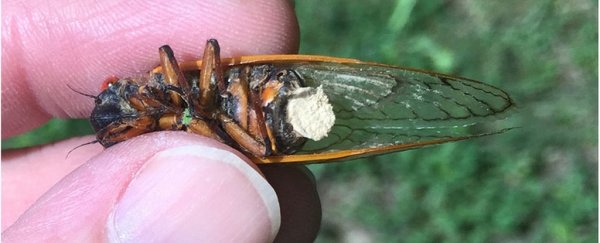The horrifying relationship between a parasitic fungus and its host has just been examined in close detail, and it reveals once again just how brutal nature can be.
Scientists now know in gruesome detail exactly how the fungus Massospora cicadina infects so many cicadas, before going on to hijack their behaviour and explode out of their abdomens, leaving the cicadas compelled to mate despite no longer have sexual organs.
The fungus is already infamous because it takes over the cicada's abdomen, as you can see in the picture above, bursting out from it to scatter its spores, and leaving the cicada with little below the waist, so to speak.
Thanks to its shocking life cycle, we've known about it since at least 1879, when the first scientific description was published.
But now researchers from the University of Connecticut have revealed new insight into how exactly it pulls off this feat.
"It's a fun story for us, not for the cicadas," said lead researcher John Cooley.
So how exactly does it manage to hijack cicada's bodies and behaviour?
As cicada nymphs prepare to emerge after spending up to 17 years maturing underground, resting spores stuck to its exoskeleton are alerted by compounds on the cicada that it's time to infect and sprout.
Roughly 2 to 5 percent of cicadas in the US are infected this way called Stage I infection, but that's not the fungus's only means of getting around.
The fungus also settles in the cicadas' abdomens, affecting both males and females. But early on, the males started acting a bit weird.
In addition to normal mating behaviours, they started flicking their wings in a manner seen only in females.
It turns out this is so they can transmit the fungus sexually.
This normally female behaviour lures in other males who will try to mate with them - but instead they pick up the fungus themselves.
And the affected males will also try and mate with females, transmitting the fungus to them, too. And, of course, infected females will transmit the fungus to unaffected males who try to mate with them.
The spores gradually fill the abdomens of all the affected cicadas, to the point of bursting them open, or in some cases even falling off entirely, scattering spores of the white fungus out of the cavity where their butts used to be.
This final act causes the cicada's sexual organs to fall off, too, but they still feel compelled to mate.
Cicadas infected by other cicadas have what the researchers call a Stage II infection, and they follow the same infection cycle.
They continue to behave normally, infecting other cicadas, and dropping spores wheresoe'er they roam.
Behavioural changes caused by parasites have been observed in many other species, including ants, snails, crabs, beetles, and even rodents, and the field is one that is proving of increasing interest to science, the researchers noted.
"This phenomenon is the ultimate evolutionary arms race, where the host loses because they are rendered sterile or evolutionarily irrelevant by the fungus in order to spread the spores," said Cooley.
They also note in their paper that other cicadas infected with unknown fungal parasites exhibit similar behaviours, raising the possibility that the "zombie parasites" that control insects include a subset that specifically hijack mating behaviours to spread like an STD.
As horrible as all of this sounds to us, this fungus has actually been part of the life cycle of cicadas for generations, and shows the potential for life to find a way through any means necessary.
The research has been published in the journal Nature Scientific Reports.
